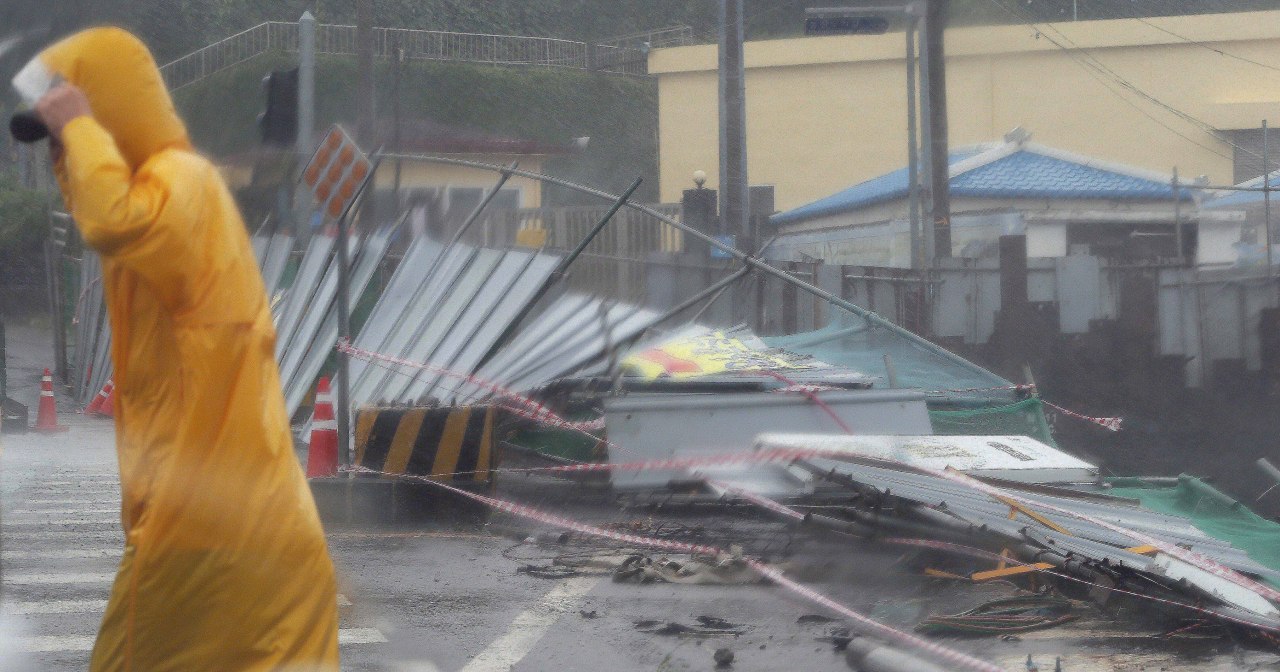Flights and ferries canceled as Typhoon Bavi arrives
By Ko Jun-taePublished : Aug. 26, 2020 - 14:11

South Korea fell under the influence of a “very strong” typhoon Wednesday, with typhoon advisories issued for some of its southern regions. Authorities are bracing for one of the most powerful typhoons of the year, which is expected to directly impact the capital region.
The Korea Meteorological Administration said Wednesday that as of 4 p.m. Typhoon Bavi was 200 kilometers west of Jeju Island and was advancing north at 22 kilometers per hour. The tropical storm had a maximum wind speed of 162 kilometers per hour and an atmospheric pressure of 945 hectopascals at its center.
The eighth typhoon of this year, which formed off the east coast of Taiwan last week, has been gaining strength and intensity over the past few days and earned the “very strong” typhoon designation at 9 a.m. Wednesday, three hours earlier than originally expected.
The “very strong” rank is the second-highest classification on the weather agency’s five-level scale introduced in May. The KMA forecasts that Bavi could develop into a “super-strong” typhoon and bring winds stronger than 200 kilometers per hour.
A typhoon with wind speeds of 194 kilometers per hour earns the “super-strong” rank. In a “super-strong” typhoon, serious damage can be expected, from trains derailing to cars and people being swept into the air, the KMA warned.
“Bavi could develop into a record typhoon while traveling through the west coast,” said Woo Jin-kyu, a forecaster at the national weather agency, during a press briefing Wednesday.
“Wind speed could change as time goes on, but it is evident that the wind will be very strong while traveling up north.”
Bavi is similar to Typhoon Lingling in 2019 and typhoon Bolaven in 2012 in terms of its strength and its course, Woo said. Lingling left four people dead or injured and caused 33.3 billion won ($28.06 million) worth of property damage, while Bolaven caused 11 deaths or injuries and cost the country 636.4 billion won.
The weather agency said it is possible that Bavi will surpass 2003’s Typhoon Maemi in terms of wind speed. Typhoon Maemi devastated many regions with gusts of up to 216 kilometers per hour.
The tropical storm is expected to travel up the Yellow Sea, reach near Seoul early Thursday and pass northwest of Pyongyang later that day before dying out near Harbin, China, Friday.
The typhoon is forecast to pour up to 500 millimeters of rain on Jeju Island, up to 150 millimeters on the Jeolla provinces and up to 100 millimeters on other regions. The influence will be greater in the country’s western regions.
The national weather agency issued typhoon advisories for Jeju Island and parts of South Jeolla Province on Wednesday morning. More regions will receive similar alerts when the typhoon advances north.
From the advisories in effect, all 330 flights to and from Jeju International Airport scheduled until 3 p.m. Wednesday have been canceled, and more flights may be canceled later. Gimhae International Airport in South Gyeongsang Province canceled 54 domestic flights.
According to the Korea Maritime Transportation Safety Authority, thousands of ships have been docked over safety concerns off Jeju Island and in other southern regions.
Trains have stopped running along routes serving the country’s southern regions, and traffic has been restricted on a number of roads. Access to many national parks is restricted as well.
In response, the Ministry of the Interior and Safety on Wednesday elevated the weather alert level from “caution” to “alert,” the second-highest of four levels of vigilance, after raising it from “attention” to “caution” Monday.
The ministry advised people to stay indoors and instructed district authorities to take preemptive measures to minimize damage from strong winds. It also asked emergency evacuation facilities to strictly follow quarantine measures.
Property damage has already been reported in a number of regions down south as the typhoon continued to advance. No deaths or injuries have been reported as of press time.
Prime Minister Chung Sye-kyun urged the disaster response team in a meeting Wednesday to exert its full effort to minimize property damage from the typhoon and keep the casualty count to zero.
Gyeonggi Province issued its highest alert level in preparing for Bavi, closing parking lots, roads and construction sites deemed at risk of damage.
Authorities are especially worried as many regions are yet to recover from a deadly streak of torrential rains that ended earlier this month accompanied by Typhoon Jangmi. Bavi is the second typhoon to hit the country directly this season, after Jangmi in early August.
The country suffered devastating damage from its longest monsoon season on record, which lasted 54 days starting June 24. Some 37 people died, with five others still missing. More than 30,000 cases of property damage were reported.
By Ko Jun-tae (ko.juntae@heraldcorp.com)
The Korea Meteorological Administration said Wednesday that as of 4 p.m. Typhoon Bavi was 200 kilometers west of Jeju Island and was advancing north at 22 kilometers per hour. The tropical storm had a maximum wind speed of 162 kilometers per hour and an atmospheric pressure of 945 hectopascals at its center.
The eighth typhoon of this year, which formed off the east coast of Taiwan last week, has been gaining strength and intensity over the past few days and earned the “very strong” typhoon designation at 9 a.m. Wednesday, three hours earlier than originally expected.
The “very strong” rank is the second-highest classification on the weather agency’s five-level scale introduced in May. The KMA forecasts that Bavi could develop into a “super-strong” typhoon and bring winds stronger than 200 kilometers per hour.
A typhoon with wind speeds of 194 kilometers per hour earns the “super-strong” rank. In a “super-strong” typhoon, serious damage can be expected, from trains derailing to cars and people being swept into the air, the KMA warned.
“Bavi could develop into a record typhoon while traveling through the west coast,” said Woo Jin-kyu, a forecaster at the national weather agency, during a press briefing Wednesday.
“Wind speed could change as time goes on, but it is evident that the wind will be very strong while traveling up north.”
Bavi is similar to Typhoon Lingling in 2019 and typhoon Bolaven in 2012 in terms of its strength and its course, Woo said. Lingling left four people dead or injured and caused 33.3 billion won ($28.06 million) worth of property damage, while Bolaven caused 11 deaths or injuries and cost the country 636.4 billion won.
The weather agency said it is possible that Bavi will surpass 2003’s Typhoon Maemi in terms of wind speed. Typhoon Maemi devastated many regions with gusts of up to 216 kilometers per hour.
The tropical storm is expected to travel up the Yellow Sea, reach near Seoul early Thursday and pass northwest of Pyongyang later that day before dying out near Harbin, China, Friday.
The typhoon is forecast to pour up to 500 millimeters of rain on Jeju Island, up to 150 millimeters on the Jeolla provinces and up to 100 millimeters on other regions. The influence will be greater in the country’s western regions.
The national weather agency issued typhoon advisories for Jeju Island and parts of South Jeolla Province on Wednesday morning. More regions will receive similar alerts when the typhoon advances north.
From the advisories in effect, all 330 flights to and from Jeju International Airport scheduled until 3 p.m. Wednesday have been canceled, and more flights may be canceled later. Gimhae International Airport in South Gyeongsang Province canceled 54 domestic flights.
According to the Korea Maritime Transportation Safety Authority, thousands of ships have been docked over safety concerns off Jeju Island and in other southern regions.
Trains have stopped running along routes serving the country’s southern regions, and traffic has been restricted on a number of roads. Access to many national parks is restricted as well.
In response, the Ministry of the Interior and Safety on Wednesday elevated the weather alert level from “caution” to “alert,” the second-highest of four levels of vigilance, after raising it from “attention” to “caution” Monday.
The ministry advised people to stay indoors and instructed district authorities to take preemptive measures to minimize damage from strong winds. It also asked emergency evacuation facilities to strictly follow quarantine measures.
Property damage has already been reported in a number of regions down south as the typhoon continued to advance. No deaths or injuries have been reported as of press time.
Prime Minister Chung Sye-kyun urged the disaster response team in a meeting Wednesday to exert its full effort to minimize property damage from the typhoon and keep the casualty count to zero.
Gyeonggi Province issued its highest alert level in preparing for Bavi, closing parking lots, roads and construction sites deemed at risk of damage.
Authorities are especially worried as many regions are yet to recover from a deadly streak of torrential rains that ended earlier this month accompanied by Typhoon Jangmi. Bavi is the second typhoon to hit the country directly this season, after Jangmi in early August.
The country suffered devastating damage from its longest monsoon season on record, which lasted 54 days starting June 24. Some 37 people died, with five others still missing. More than 30,000 cases of property damage were reported.
By Ko Jun-tae (ko.juntae@heraldcorp.com)



![[Exclusive] Korean military set to ban iPhones over 'security' concerns](http://res.heraldm.com/phpwas/restmb_idxmake.php?idx=644&simg=/content/image/2024/04/23/20240423050599_0.jpg&u=20240423183955)




![[Herald Interview] 'Amid aging population, Korea to invite more young professionals from overseas'](http://res.heraldm.com/phpwas/restmb_idxmake.php?idx=644&simg=/content/image/2024/04/24/20240424050844_0.jpg&u=20240424200058)
![[Pressure points] Leggings in public: Fashion statement or social faux pas?](http://res.heraldm.com/phpwas/restmb_idxmake.php?idx=644&simg=/content/image/2024/04/23/20240423050669_0.jpg&u=)









